Additional information about Namibia

On this page we have compiled a lot of information for a holiday in Namibia. Those who travel through Namibia on their own should read carefully the tips for the self-driving; As then one can save some trouble and efforts.
Practical tips
Namibia is one of the safest African countries for travelling. This is still so, although the criminality increases and specially in the cities, one has to be careful, specially in the evenings.
A passport of minimum 6 months validity is needed for travelling into the country. To the contrary, a visa is not needed. During the flight, some entry forms are distributed that have to be filled out. During a trip to Namibia one does not have to be afraid of a jetlag, as the time difference is of only one hour.
The official currency of the country is the Namibian Dollar, but the African Rand is equally accepted. Credit cards are accepted in almost all accommodations and in many shops. But as the petrol has to be always paid in cash and the tips and also the purchases in the markets, etc. are always paid cash, it is recommendable to change a certain sum before the trip and/or at the airport of Windhoek.
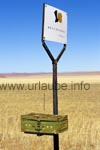
It is relatively easy to telephone in the cities of Namibia or in their proximity, but to the contrary, the mobile phone reception if oftenly not possible. The number of the national telephone information is 1155, the 1193 of the international and the country code to Germany is 0049, while from Germany one has to dial 00264 for Namibia.
The official language is English, but due to the past, the German language and also Afrikaans are widely spread. For Germans, it is almost always possible to communicate in Namibia.
Also concerning the health precautions, Namibia is exemplary for Africa. The medical assistance is well developed. Anyway, one should not miss to get an international health insurance. Vaccinations are not obligatory and oftenly also not necessary. There is mainly in the Caprivi strip danger of malaria and also during the excursions to the neighboured countries to the Victoria Falls and to the Okavangodelta. Besides, the very dry climate is the best prophylaxis against malaria.
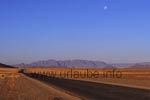
The tap water can be drank without a problem and the hygienic standards of the restaurants are equal as the ones of the European restaurants, so that there is not to care about. There is a certain increased risk in different feverish diseases, hepatitis, tuberculosis and hydrophobia, but in total, there is also no big danger. As it is the case in the whole of South Africa, aids is a problem. Officially, this disease does not exist but inofficially, the estimation is of 30 to 40 percent infected persons.
In Namibia, it is not a problem to drive a car, despite of the left-hand driving. The traffic density is very low and the roads are, for African standards, good. The petrol prices are clearly below the ones of Germany; Nevertheless, one should avoid driving in the darkness.
Electricity can be a problem. Many farms and lodges are not connected to the public electricity net and get the electricity from generators. This is why, specially at nights, no electricity is guaranteed. The plugs are three-poled so that an adapter is needed.
There are no legally regulated shop closing times, but many shops already close at 05.00 p.m. Most of the times, the banks and post offices open form Monday to Fraday from abut 09.00 a.m. up to 03.30 p.m. and on Saturdays from about 08.30 a.m. up to 11.00 a.m.
Within the whole country, the police of Namibia can be called under the number 10111. MedRescue Namibia, an emergency rescue service of the "flying doctors" is reachable under the emergency number 061-230505, another rescue service is Aeromed Namibia CC with the emergency number 061-249777.
Travel agents
There is really no lack of travel agents offering trips to Namibia, no matter as a complete package or for combining as per one's taste. Apart from the big travel agencies known everywhere, there are many smaller ones that have specialised in individual trips. Some of them only have Africa and/or african countries in offer.
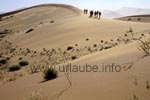
Many times, the big travel agencies are cheaper, but therefore less individual most of the times and mainly offering travel packages, while in many cases, the "specialists" are more variable, either concerning the combination of the journey as also concerning the advice. Most of the times, the latter can be only booked on the internet, as they are not represented all over Germany as it is the case of the big chains.
Over the page Namibia Tourism there are numerous addresses of these special providers available and also subdivided in special fields of interest like hunting trips, activity trips, group trips, study trips or self-drivers.
We had our first trip organized by DERTOUR, the next ones then from Iwanowski's Individuelles Reisen (Iwanowski's individual travelling); We were satisfied with both, whereby the advice of Iwanowski was obviously better focusing on the individual requirements and on country-specified characteristics. This is understandable, as they are specialists that only work with Africa trips, while in case of the general travel agencies, the range of destinations offered is uncomparable wider. The disadvantage of this is that one has to get in touch via internet or telephone, a thing that is surely not a big problem but also cannot replace a personal talk in the travel agency.
Tips for self-drivers
By planning a trip in which one wants to get closer to the country and the people and one wants to explore some different areas, the question comes up whether one wants to book the tour as a guided round trip or as self-driver. Of course, the latter offers the big advantage to set the stretches, the times and the places mainly independently. But this of course also means that one has to trust the own driving performance in a foreign country, a thing that is not always easy in some places.
Namibia with its endless wideness, the few paved roads and the many unpaved roads and sand pistes makes one doubt. But we can only recommend everybody who is considering to drive by himself to do so. Driving a rented car is less problematic as it seems at first and the experiences one enjoys are fascinating.
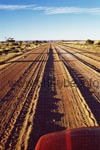
It is advantageous to book either the rental car as also the accommodations from Germany. Then, during the handing over, a credit card is needed for the deposit and before starting the round trip it is important to have changed enough Namibian dollar. It is certainly possible to pay almost everywhere with the credit card but it is legally prescribed that the petrol has to be paid in cash at the gas stations.
An all-wheel-drive car is surely advantagerous but it is not indispensable in Namibia. In our first jouney we rented a normal car of average performance, then in our second tour a 4x4, and on the third again a normal car. We could do it with all three cars without any problem. As a 4x4 additionally strains the travel budget, there is to consider which variant to take. Herein, the exception is the outer north-west of the country, the Kaokoveld. There, the road conditions are very extreme, driving on one's own is not recommendable here and there is no chance without an all-terrain vehicle.
What is very important - and even an absolute must - are some gallons of potable water. The best is to buy them straight after taking over the rented car and, of course, one has to care to have tools and a replace wheel.
Generally, the quality of the rented car and the technical state are excellent and we barely saw some older models. Many times, we even got a bigger car than the one we actually rented. Also the provision of petrol is relatively unproblematic. In some places as for example Keetmannshoop, one comes across to a gas station in every street corner. But anyway, one should not underestimate the big distances and the extreme desertness, specially in the south, and preferrably tank more, even though the tank is only half-emptied.
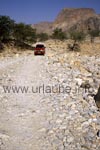
We knew from the travel guides and from what we heard from other visitors of Namibia that some heavy and even fatal accidents are nothing unusual and many people do not arrive at their destination with the rented car. This is certainly right. But the conclusion from our personal experience is that in most of the cases, the cause is due to the careless behaviour of the driver. Despite of a few paved main roads, the road network of Namibia mainly consists on gravel and sand roads. They certainly are in a good general condition, but one has to adapt one's driving style to that and not exceed in any case the maximum velocity of about 60 km/h. Specially after a rare rain, these pistes can turn to some dangerous slippery slides.
This is why the distance to each of the day destinations should not exceed 400 km, 250 to 300 km are more reasonable. Finally, one wants to enjoy the landscape, to have one or to breaks and also, nobody is secured against an eventual breakdown.
In Namibia, the traffic is left-handed, a thing that is very unusual to us. But this also results not to be a problem. Those who do not know this from other countries will learn soon to handle this.
What is surprising and absolutely unusual for central Europeans is the wideness of the country. At the beginning, one thinks that one should have already arrived long ago to the destination. But after looking on the map one realizes that not even half of the stretch is done. But one also gets rapidly used to this.
Namibia has only about 1,8 million inhabitants but a territory double as big as germany. In this huge country there are in total less cars than in Hamburg. This information should be motivating fot those who are not used to the left-hand traffic. Thus, out of the cities, there are very few cars on the way, a thing that on one hand can be very pleasant, but on the other hand induces the risk of exhaustion. The vehicles coming from the opposite direction are recognized from a distance by their dust cloud so that one can adapt to this in time. Being overhauled is not a pleasure. Due to the own cloud of dust one does not see the other car until it suddenly appears beside one and the driver is greeting friendly. Then one has to decelerate immediately, as behind the car that is passing by, some stones and grit crash against the carriage and the windscreen of the own car. We apparently could keep our windscreen intact due to the immediate decelerating in each overtaking manoeuvre.
It is not difficult to get orientated. We coped very well with the map of the office NAMIBIA TOURISM. Each Namibian road is marked by a number and/or letter. B-roads are paved main roads, C-roads are gravel highways, and only the gravel side roads described by a number and the P-paths were mainly private ways. if one accurately drives in accordance to this road descriptions, one cannot miss the destination.
In any case it is recommendable to arrive in time at the lodge or the guest farm, as many times, a farm trip is offered that almost takes place in the late afternoon.
Photo tips
Africa is not located just around the corner, at least not for us Europeans. Those who get equipped for travelling to there will guaranteedly pack a camera. But while the sunglasses and adequate clothes are packed into the suit case as a matter of course, it is easily forgotten that also the photo equipment has some requirements in order to cope with such extreme conditions.
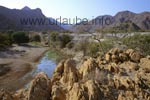
One should take the necessary precautions for the uncommon foto motifs in Africa so that everything goes well. There is nothing that makes one more furious than standing in front of an exotic motif and be out of films or have a full memory card.
Today, the memory cards for the digital cameras are offered with a big capacity, depending on the model and the camera in use, the capacity can be up to 8 GB. But it is anyway better to take several ones of medium capacity than one "big" memory card. If the card in use should not work for any reason and it is the only one taken to the journey, then the whole excellent digital camera is useless at first. If one wants to make a lot of pictures, it is recomendable to use a mobile memory medium on which the photos can be saved. Thereby, the available memory cards can be deleted and reused.
Batteries are as important as the films and the memory cards; Even if one does not travel on one's own but in a guided group of people, in Africa, one often does not get to the next city until a couple of days. And then it is still questionable if there is a specified shop selling the needed batteries.
It is equally important to get informed about the type of plug used in the country one wants to travel to and to take the respective adapter to the journey. Specially when the accumulators have to be loaded one is probably "left out in the rain".
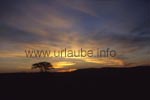
If there is the choice, one should preferrably take a reflex camera to the Africa trip. It offers an unbeatable quality in the drawing and the biggest variability due to the appliance of interchangeable lenses.
As second choice there are the rangefinder cameras with a large zoom area. They also mainly offer a good quality and enable to handle either creatively as also technically in good quality such different motifs as portrait, landscape, overview or details located in a distance, fast animals and plants. In case of digital cameras, those with an optical zoom are preferrable, as a digital zoom is actually only a "bluff package" and often disappointing.
A drawback of the digital camera in Africa is its high power requirement. A possibility to load the accumulators with electricity is not given any time and everywhere at all. In the guest farms and lodges where there is usually nothing missing, it can happen that the plugs do not permanently provide electricity.
Beside the camera, memory cards and batteries one should also consider some other things. Before the journey, one should make a check of the camera in order to look is everything is working right in order to avoid some unpleasant surprises. There are barely camera repair shops in Africa.
An important accessoire that is actually an indispensable one is an ultraviolett-blocking filter (short: UV-filter). Apart of its actual function it protects the objective against dust, sand and eventual scratches. It is clearly cheaper to throw away a defective UV-filter and to buy a new one than repairing the front lense of the objective.
A small bellows of plastic and an optical wiper are also indispensable. Otherwise, the dust and the sand cause some nasty scratches on the film or some spots on the sensor of the digital camera. In the worst case, the technique can totally break down.
It sounds absurd but is true: also in such a shining bright place as Africa, a tripod can be indispensable. For example for zooming in with an objective of long focal length and a high f-stop (small aperture) an animal or a detail of a landscape that is located in a distance in a format fitting size, in order to catch a glamorous light mood in the evening dawn in the aperture stop 22 due to the richness of detail in the landscape, in order to adjust the close-up of a part of a plant accurately, etc.
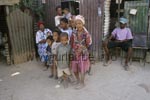
Of course it is not a pleasure to carry a tripod with 40 degrees in the shade. But apart from the fact that there are relatively light and stable ones in the same time, a monopod does also provide some good services. An old trick is, by the way, still applicable: to fix a piece of fishing line at the bush or at the camera bag and to step to the other end of the straightened line during the exposure. Therewith, the camera slam can be avoided quite successfully.
This surely sounds a little outmoded in the era of the current technique, as meanwhile, many cameras do have a picture stabilzer, but this also does not make wonders. Specially during the photographing with very long focal lengths and under unconvenient light conditions, such a picture stabilizer comes to its limits so that the good old tripod will show its true strengths.
But only the technique does not make a good picture yet. What is decisive is what the photographer sees and photographs. In Africa, there is really no lack of motifs. Those who have a faible for beautiful light moods will not be in danger in Africa to forget to photograph due to thier high enthusiasm. The strange landscapes and the exotic animals almost require to be put into the picture in an interesting way.
Of course, one should also photograph the people, their habits and customs but not forget to consider that good manners are also appreciated in Africa. In Namibia, the question whether it is possible to make a picture is almost always answered with a "yes". But people react angrily if one photographs them without having asked, maybe also from a distance with a long telephoto-objective.
The same respect applied to the human population of Africa should be also applied to the local flora and fauna. The compliance of the conservation regulations is a part of this. One should not disquiet free living animals, also in the own interest. Many of them probably react aggressively in the case of falling below the escape distance, and this is a life-threatening situation.

Back to the index Namibia
Author: Michael Nitzschke, Copyright: Patrick Wagner, www.tourist-guide.biz
|